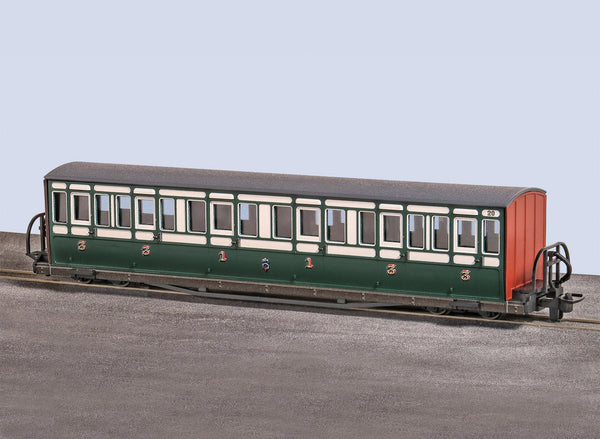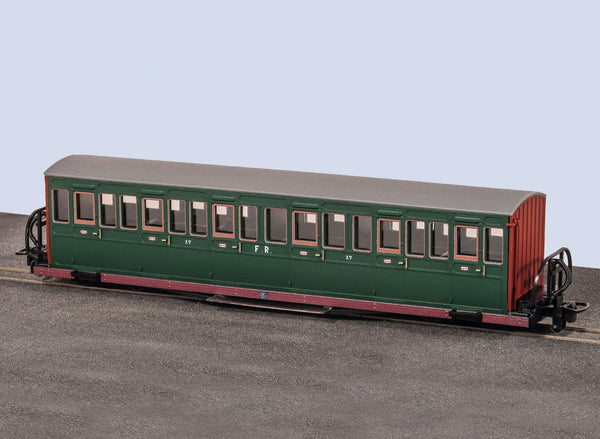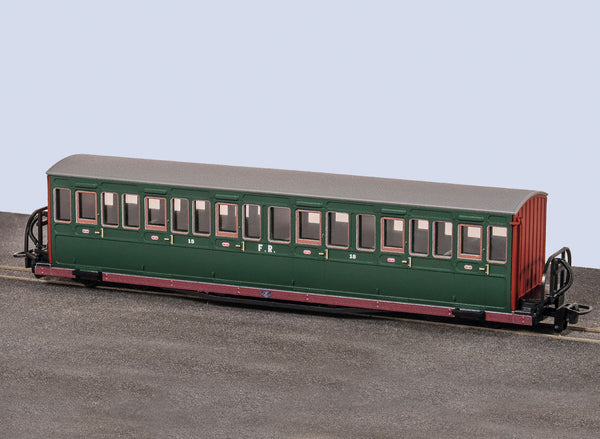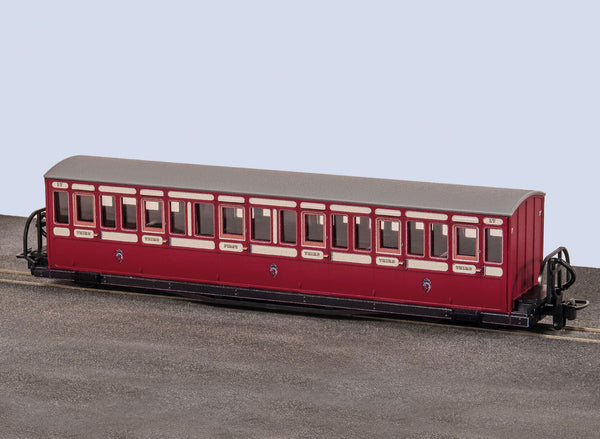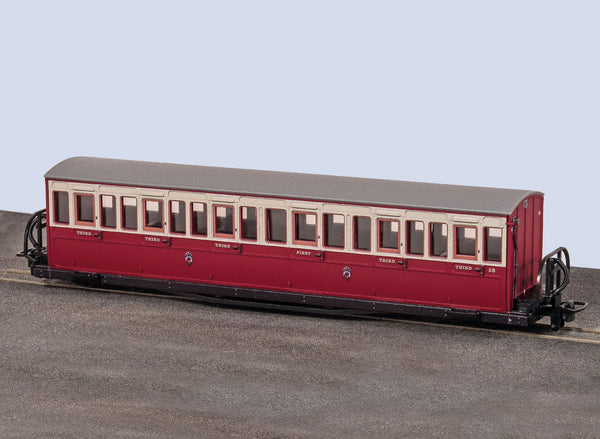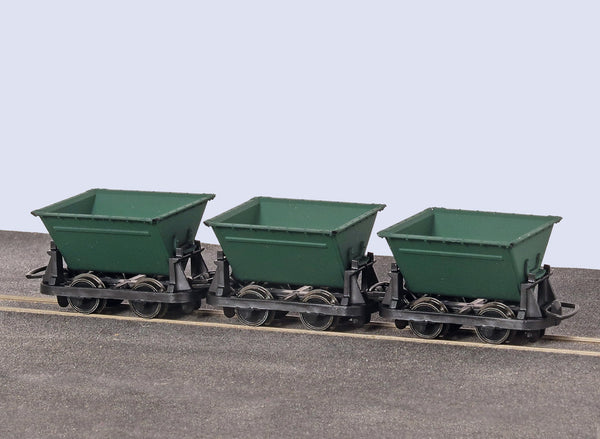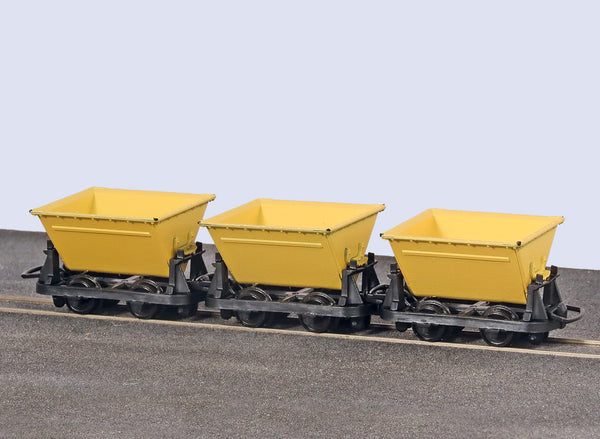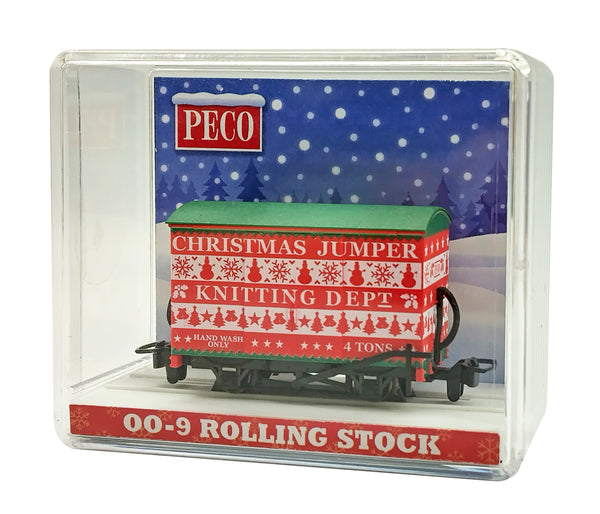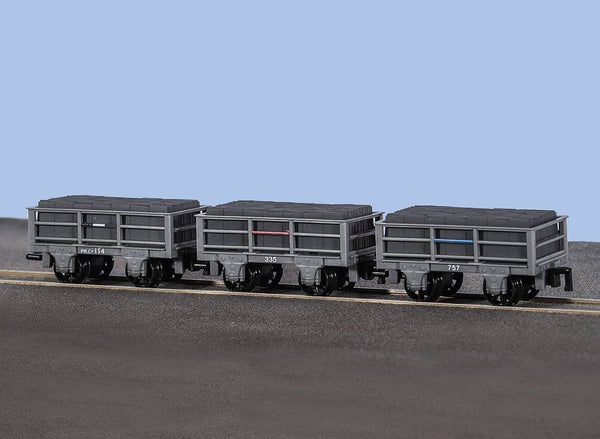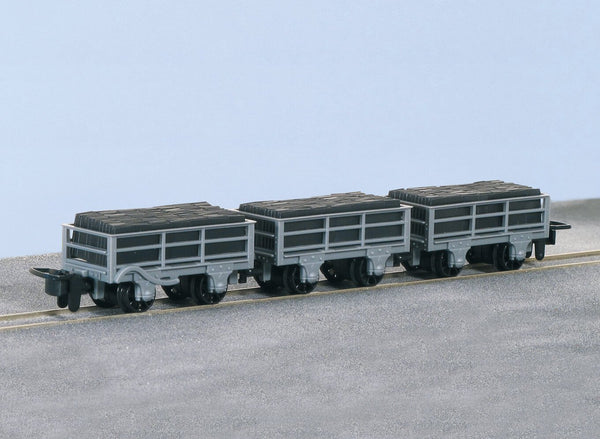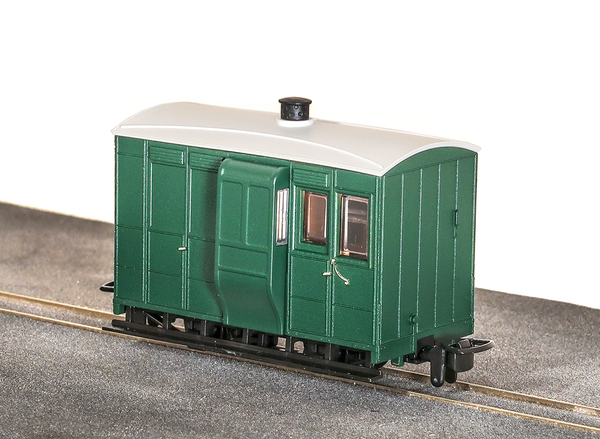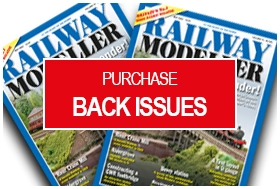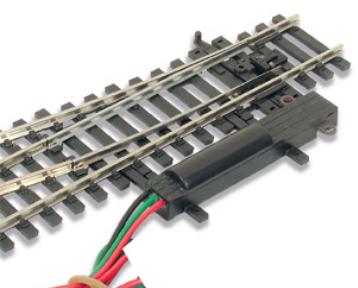DURCHSUCHEN SIE PECO-PRODUKTE
Stöbern Sie durch unser komplettes Produktportfolio.
122 Products Found
FR Short 'Bowsider' Bogie Coach - Early Preservation - Green 20
FR Short 'Bowsider' Coach - Colonel Stephens No.17
The Ffestiniog Railway operated two pairs of bogie coaches numbered 17-20 and built by Brown Marshalls & Co and Gloucester Wagon Co. They were known as ‘Bowsiders’ because of the tumblehome shape of their sides. Numbers 17 and 18, built in 1876 are shorter with one 1st class compartment. Numbers 19 and 20, built in 1879 are longer with two 1st class compartments. All four are still in service on the Ffestiniog Railway today.
In the 1920s the elaborate liveries of the Victorian era were replaced with a simple scheme of green with red end panels. It became known as the ‘Colonel Stephens’ livery, after the General Manager of the Ffestiniog Railway from 1925 until his passing in 1931. The colour scheme was used until the end of passenger operations in 1939, sometimes alongside other colours such as yellow, in the mid 1930s.
Green with red ends was applied to carriage No.20 once again from 2005 until 2024, as depicted by GR-623B.
FR Short 'Bowsider' Coach - Colonel Stephens No.18
The Ffestiniog Railway operated two pairs of bogie coaches numbered 17-20 and built by Brown Marshalls & Co and Gloucester Wagon Co. They were known as ‘Bowsiders’ because of the tumblehome shape of their sides. Numbers 17 and 18, built in 1876 are shorter with one 1st class compartment. Numbers 19 and 20, built in 1879 are longer with two 1st class compartments. All four are still in service on the Ffestiniog Railway today.
In the 1920s the elaborate liveries of the Victorian era were replaced with a simple scheme of green with red end panels. It became known as the ‘Colonel Stephens’ livery, after the General Manager of the Ffestiniog Railway from 1925 until his passing in 1931. The colour scheme was used until the end of passenger operations in 1939, sometimes alongside other colours such as yellow, in the mid 1930s.
Green with red ends was applied to carriage No.20 once again from 2005 until 2024, as depicted by GR-623B.
FR Short 'Bowsider' Coach - Red & Cream No.17
The Ffestiniog Railway operated two pairs of bogie coaches numbered 17-20 and built by Brown Marshalls & Co and Gloucester Wagon Co. They were known as ‘Bowsiders’ because of the tumblehome shape of their sides. Numbers 17 and 18, built in 1876 are shorter with one 1st class compartment. Numbers 19 and 20, built in 1879 are longer with two 1st class compartments. All four are still in service on the Ffestiniog Railway today.
The red and cream livery was first applied to a rake of carriages in 1987 for the ‘Mountain Prince’ train service. Carriage 20 was the first Bowsider to appear in the livery.
Carriages 17 and 18 had cream applied to the full upper half of the carriage. 17 had the mouldings reinstated in 1990 as depicted by GR-602A. 18 continued to have cream across the upper half throughout its time in the scheme, as represented by GR-602B. Note the ‘Brown Marshalls & Co. Ltd’ builders plate printed on the ends of the carriage.
All four Bowsiders were repainted into historic liveries in the 2000s, but the red and cream colour scheme is still seen today on the more modern carriages
FR Short 'Bowsider' Coach - Red & Cream No.18
The Ffestiniog Railway operated two pairs of bogie coaches numbered 17-20 and built by Brown Marshalls & Co and Gloucester Wagon Co. They were known as ‘Bowsiders’ because of the tumblehome shape of their sides. Numbers 17 and 18, built in 1876 are shorter with one 1st class compartment. Numbers 19 and 20, built in 1879 are longer with two 1st class compartments. All four are still in service on the Ffestiniog Railway today.
The red and cream livery was first applied to a rake of carriages in 1987 for the ‘Mountain Prince’ train service. Carriage 20 was the first Bowsider to appear in the livery.
Carriages 17 and 18 had cream applied to the full upper half of the carriage. 17 had the mouldings reinstated in 1990 as depicted by GR-602A. 18 continued to have cream across the upper half throughout its time in the scheme, as represented by GR-602B. Note the ‘Brown Marshalls & Co. Ltd’ builders plate printed on the ends of the carriage.
All four Bowsiders were repainted into historic liveries in the 2000s, but the red and cream colour scheme is still seen today on the more modern carriages
Hudson Rugga V-Skips (Green)
The familiar Rugga V-Skip 'tipping' wagon design was introduced in the 1930s - a development of the Robert Hudson company, based in Leeds. They could be supplied to the customer's specific requirements, with a skip size ranging from 13.5 to 54 cubic feet (0.38 to 1.53 cubic metres), and in most track gauges. The design allows the skip to tip in either direction, perfect for small industrial railways that needed to move and unload materials quickly and efficiently. The company even boasted that at any one time several thousand could be supplied from stock! These are supplied in an attractive display box of three.
Hudson Rugga V-Skips (Yellow)
The familiar Rugga V-Skip 'tipping' wagon design was introduced in the 1930s - a development of the Robert Hudson company, based in Leeds. They could be supplied to the customer's specific requirements, with a skip size ranging from 13.5 to 54 cubic feet (0.38 to 1.53 cubic metres), and in most track gauges. The design allows the skip to tip in either direction, perfect for small industrial railways that needed to move and unload materials quickly and efficiently. The company even boasted that at any one time several thousand could be supplied from stock! These are supplied in an attractive display box of three.
L&B 8-Tonnen-Bogie-Goods-Brake-Van OO-9
Die nächste neue Lackierung für den L&B Goods Brake Van ist dieses schlichte graue Modell ohne Beschriftung, das sich an den freiberuflichen Modellbauer richtet.
Das Entfernen aller Verweise auf die Lynton and Barnstaple Railway, aber das Weglassen nützlicher Details wie Leergewicht und Bauschild wird denjenigen OO-9-Modellbauern gefallen, die ihre eigene einzigartige und individuelle Eisenbahn im Miniaturformat erstellen möchten.
OO-9 Bug Box Coach, Lackierung der 1970er/80er Jahre, Zoowagen
Unsere NEUEN „Bug Box“-Wagen der Ffestiniog Railway tragen die schlichte rote Lackierung aus der Denkmalschutzzeit der 1970er und 1980er Jahre. Sie mögen schlicht sein, aber wenn Sie genau hinschauen, werden Sie feststellen, dass es tatsächlich viele sehr feine Details gibt, darunter das FR-Emblem, die Türgriffe und die laufenden Nummern.
OO-9 2 Tonnen Schieferwagen der Festiniog Railway
Züge mit Schieferwagen wurden früher per Schwerkraft von den Steinbrüchen in Blaenau Ffestiniog zum Hafen von Porthmadoc gefahren. Dieses Modellpaket besteht aus 3 ungebremsten Fahrzeugen und verfügt über herausnehmbare Schieferladungen, die praktischerweise hohl sind, was dem Modellbauer die zusätzliche Möglichkeit gibt, weitere hinzuzufügen Gewicht ggf.
Etwa jeder fünfte Wagen war mit Bremsen ausgestattet. Diese waren im Zug verteilt und so gedreht, dass sich die Bremsgriffe alle auf derselben Seite des Zuges befanden und in Richtung Porthmadog zeigten. Auf den Seitenstangen waren verschiedene Farben angebracht, um die verschiedenen Schieferabbauunternehmen zu kennzeichnen. Unsere Pakete enthalten eine zufällige Auswahl davon. Da diese Waggons in der Regel in langen Zügen verkehren, verfügen die Modelle über semipermanente Kurzkupplungen in den NEM-Aufnahmen. Diese können mit einer Spitzzange herausgezogen und durch herkömmliche OO-9-Ring-Kupplungen (im Lieferumfang enthalten) an jedem Ende des Rechens ersetzt werden.
OO-9 2 Tonnen Schieferwagen der Festiniog Railway
Züge mit Schieferwaggons wurden früher per Schwerkraft von den Steinbrüchen in Blaenau Ffestiniog zum Hafen von Porthmadoc gefahren. Dieses Modellpaket mit 3 fahrbereiten Waggons enthält 1 gebremstes Fahrzeug und abnehmbare Schieferladungen, die bequem hohl sind und dem Modellbauer so eine zusätzliche Option bieten bei Bedarf noch etwas Gewicht hinzuzufügen.
Etwa jeder fünfte Wagen war mit Bremsen ausgestattet. Diese waren im Zug verteilt und so gedreht, dass sich die Bremsgriffe alle auf derselben Seite des Zuges befanden und in Richtung Porthmadog zeigten. Auf den Seitenstangen waren verschiedene Farben angebracht, um die verschiedenen Schieferabbauunternehmen zu kennzeichnen. Unsere Pakete enthalten eine zufällige Auswahl davon. Da diese Waggons in der Regel in langen Zügen verkehren, verfügen die Modelle über semipermanente Kurzkupplungen in den NEM-Aufnahmen. Diese können mit einer Spitzzange herausgezogen und durch herkömmliche OO-9-Ring-Kupplungen (im Lieferumfang enthalten) an jedem Ende des Rechens ersetzt werden.
OO-9 4-Rad-Bremswagen grün
Diese entzückenden fahrbereiten Reisebusse basieren auf denen, die auf der Glyn Valley Tramway eingesetzt werden. Dieses schlichte grüne Fahrzeug ist ideal für Modellbauer, die ihre eigene imaginäre Schmalspurstrecke erstellen möchten, oder für diejenigen, die sie an einen anderen Prototyp anpassen möchten. Ein passender offener Reisebus (Ref. GR-520UG) und ein geschlossener Reisebus (Ref. GR-500UG) sind erhältlich; Alle drei Fahrzeuge werden auch in schlichtem Rot hergestellt (Ref. GR-500UR, GR-520UR und GR-530UR).


